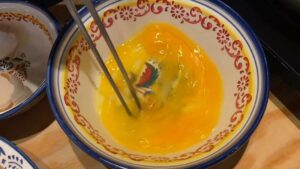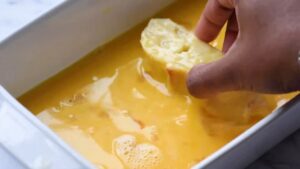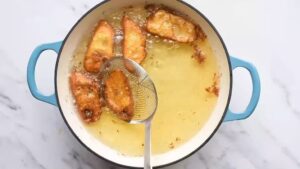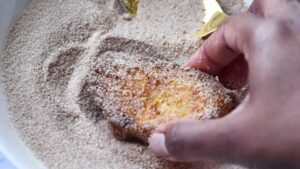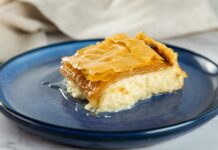
Rabanada is a holiday favorite in Brazil. It is the Brazilian version of French toast, made with slices of crusty bread soaked in a sweet custard, fried until golden, and rolled in cinnamon sugar.
Families love to enjoy it fresh and warm during Christmas, whether for breakfast or as a sweet treat later in the day. It is simple to make and a great recipe to share with loved ones.
For travelers, it is a magical season filled with good food and warm traditions. Rabanada is one of those foods that brings people together, and now you can make it at home to enjoy the taste of a Brazilian Christmas.
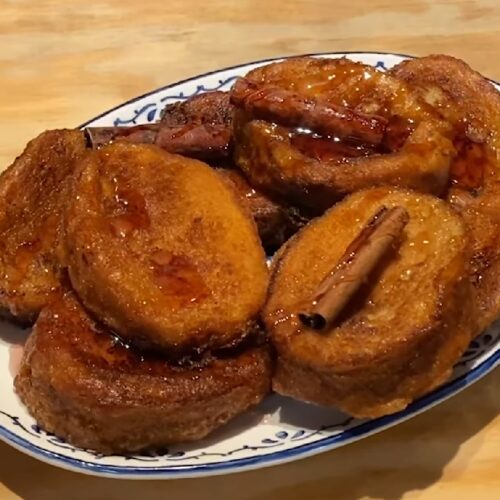
Recipe for Rabanada
Equipment
- Medium saucepan
- Large mixing bowl
- Whisk
- Large Dutch oven or deep skillet
- Deep-fry thermometer
- Slotted spoon
- Paper towels
- Shallow bowls for dipping
- Plate or tray for serving
Ingredients
- 3 Cups Whole milk
- ½ Cup Sweetened condensed milk
- 3 Cinnamon sticks
- Freshly grated nutmeg to taste
- Pinch of salt
- 2 Tbsp Vanilla extract
- 3 Whole Large eggs
- 1 Loaf Day-old French baguette or Italian bread, sliced 1-inch thick
- Vegetable oil for frying
- 1 Cup Granulated sugar
- 1 Tbsp Tablespoon ground cinnamon
Instructions
- Prepare the Milk MixtureCombine milk, sweetened condensed milk, cinnamon sticks, nutmeg, and salt in a medium saucepan.Heat over medium heat until steaming but not boiling.Remove from heat, cover, and allow to cool to room temperature.Stir in the vanilla extract.
- Whisk the EggsIn a separate bowl, whisk the eggs until smooth and fully combined.
- Heat the OilPour vegetable oil into a Dutch oven or deep skillet, filling it about 2 inches deep.Heat the oil to 360°F, using a deep-fry thermometer to maintain consistent temperature.
- Soak the BreadDip each slice of bread into the cooled milk mixture, soaking for several seconds on each side.Immediately coat both sides of the bread in the whisked eggs.
- Fry the BreadCarefully place the soaked slices into the hot oil.Fry each side for 1-2 minutes until golden brown. Avoid overcrowding the pan to ensure even frying.
- Drain Excess OilUse a slotted spoon to remove the fried slices and place them on a paper towel-lined plate to drain.
- Coat with Cinnamon SugarMix granulated sugar and ground cinnamon in a shallow bowl.Roll each warm slice of fried bread in the mixture until thoroughly coated.
- Serve WarmArrange the Rabanada on a serving platter.Serve immediately with optional toppings like whipped cream, fresh berries, or vanilla ice cream.
Video
Notes
- Bread Selection: Day-old bread absorbs the custard better without falling apart. If fresh bread is all you have, lightly toast it before use.
- Oil Temperature: Keep a steady temperature of 360°F to ensure the Rabanada is crispy and not overly greasy.
- Timing: Coat the bread in cinnamon sugar while it’s still warm so it adheres perfectly.
FAQs
1. What is the origin of Rabanada?
Rabanada has roots in Portugal, where a similar dish called “fatias douradas” (golden slices) is a traditional treat. The dish made its way to Brazil during the colonial period and became a cherished holiday recipe, adapted with local flavors like sweetened condensed milk.
2. Can I use gluten-free bread to make Rabanada?
Yes, you can use gluten-free bread to make Rabanada. Look for a crusty gluten-free loaf that will hold up well during soaking and frying. Make sure the bread is slightly stale for the best results.
3. How do Brazilians typically enjoy Rabanada during the holidays?
In Brazil, Rabanada is enjoyed not only as breakfast but also as a dessert or afternoon snack. It is often served alongside coffee, tea, or even a glass of chilled sparkling wine during Christmas celebrations.
4. Can Rabanada be made in an air fryer?
Yes, Rabanada can be adapted for an air fryer. After soaking and coating the bread, place the slices in a preheated air fryer at 360°F. Spray lightly with oil and cook for about 8-10 minutes, flipping halfway through, until golden and crispy.
Conclusion
Rabanada is a simple and delicious recipe that brings the spirit of Christmas in Brazil to your home. Its crispy outside, soft center, and sweet cinnamon coating make it a holiday favorite that’s easy to share with loved ones.


